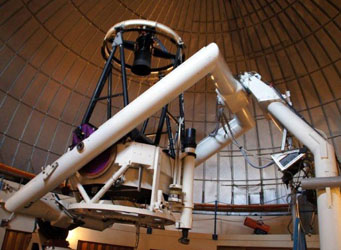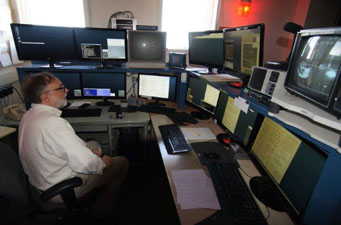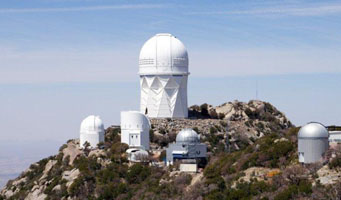| Dutch astronomy writer and S&T contributing editor Govert Schilling visits observatories in southern Arizona. |

The 1.5-meter Catalina Sky Survey telescope on Mt. Lemmon.
Govert Schilling
Beshore shows me the latest addition to the CSS: a 1-m telescope, also at Mount Lemmon, that will be used for follow-up observations. It will see first light later this year. Meanwhile, plans have been drawn up for a much larger, $30,000,000 CSS-II, that would use six 72-inch (1.8-m) mirrors on three separate mounts. Says Beshore: "If I have to put Google or Domino Pizza on the side of the telescope [to fund it], I'll do it."

Bob McMillan at the controls of the Spacewatch telescopes.
Govert Schilling
At Kitt Peak National Observatory, some 45 miles (70 km) southwest of Tucson, the Spacewatch Project also searches for asteroids and NEOs. Spacewatch, led by Bob McMillan, uses a 1.8-meter and a 0.9-meter telescope. Asteroid 2005 YU55, a 400-meter chunk of stone that will zip past the Earth at just 200,000 miles (325,000 km) on November 8th, was discovered by Spacewatch.
In the Kitt Peak kitchen, I enjoy a Mexican dinner with McMillan and with Steve Pompea, the public information officer of the National Optical Astronomy Observatory (NOAO), which runs the observatory. Pompea shows me around most of the telescopes at Kitt Peak, including the slender and compact 3.5-meter WIYN Observatory and the impressive McMath-Pierce solar telescope. Never before have I seen so many telescopes on one single mountain.

The 4-meter Mayall Telescope dominates the skyline of the Kitt Peak National Observatory.
Govert Schilling
And I'm even more impressed by the amount of public outreach carried out at Kitt Peak. Most telescopes have viewing galleries for visitors. There's a great visitor center with a nice shop. There are guided tours and stargazing sessions, using a dedicated 16-inch (40-cm) telescope. Every year, thousands of people find their way to the beautiful and friendly site, which is dominated by the tall building of the 4-meter Mayall telescope.
Unfortunately, the darkness of Kitt Peak's night sky is threatened by (slowly increasing) light pollution — not so much from nearby Tucson, which is pretty astronomy-friendly, but from remote cities like Casa Grande and even from Phoenix. "It's worrisome," says Pompea.
That evening, at the Sky Bar on 4th Avenue, I marvel at Saturn as seen through Robby Tackett's telescope. Yes, this is something everybody should see. And if you've never been to Kitt Peak, don't wait too long.
Part 2 of this blog, about the MMT Observatory and the Large Binocular Telescope, can be found here.
 2
2
Comments
Tom Hoffelder
May 3, 2011 at 1:28 pm
On Thurs 4/28, AAVSO announced a supernova in NGC 3972. This was a chance for amateurs with 8 inch scopes and larger to see, on a weekend with no moon, a star that exploded 70 million years ago. Instead we get things like this and shutting down SETI projects (I know, that was before the SN, but it is relevant). Maybe there is something here about the supernova, but I have not been able to find it. Luckily I have a friend in the AAVSO who told me about it on Thursday. This allowed me and at least three other observers, in addition to herself, to see it on the weekend. Since I live in New England, Saturday may have been my only chance with no moon.
You must be logged in to post a comment.
SFGagnon
May 11, 2011 at 12:01 pm
Once upon a time, Sky and Telescope maintained an email notification list for events such as the supernova you mention. Anyone know what happened to it? Getting notified about events such as the supernova in NGC 3972 would be useful.
You must be logged in to post a comment.
You must be logged in to post a comment.